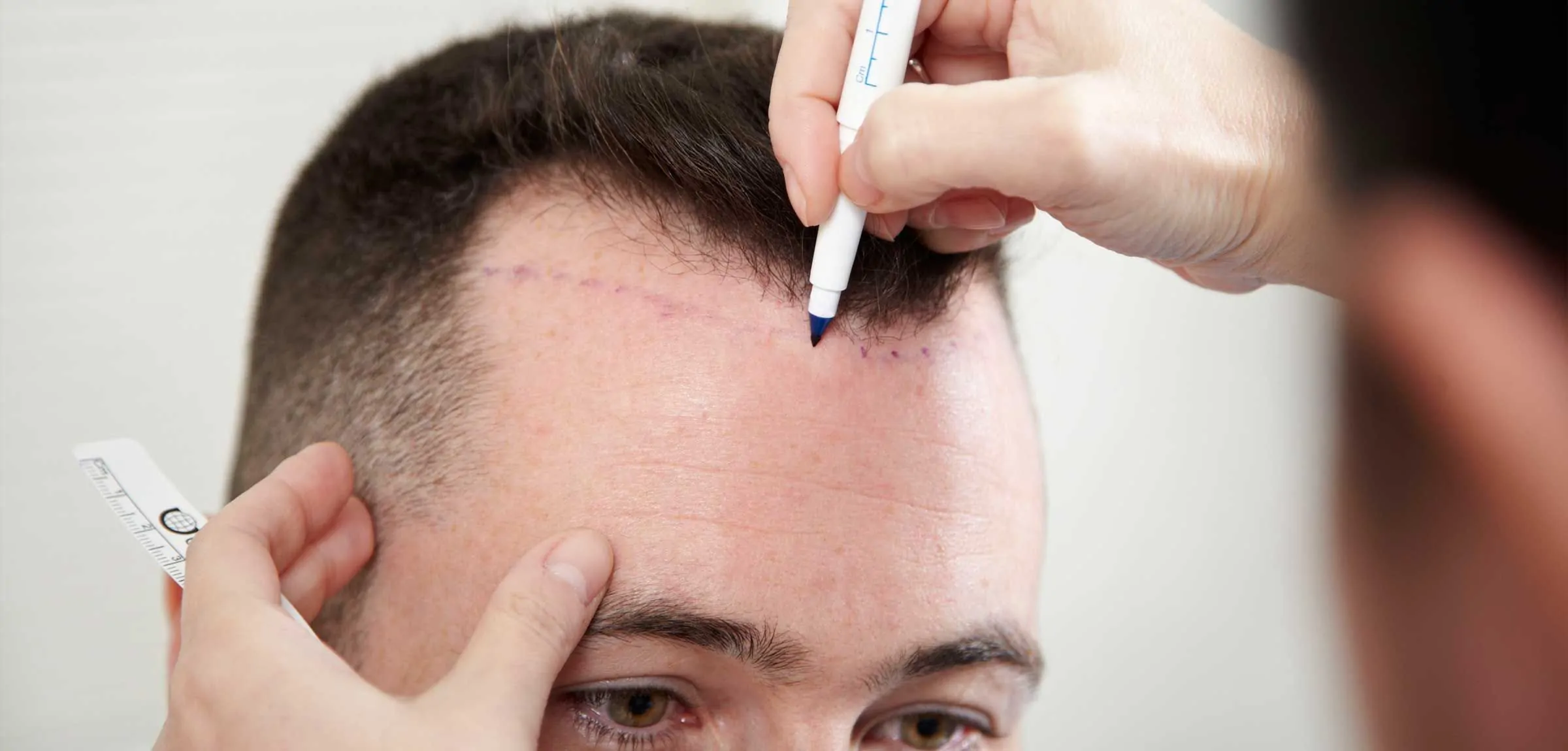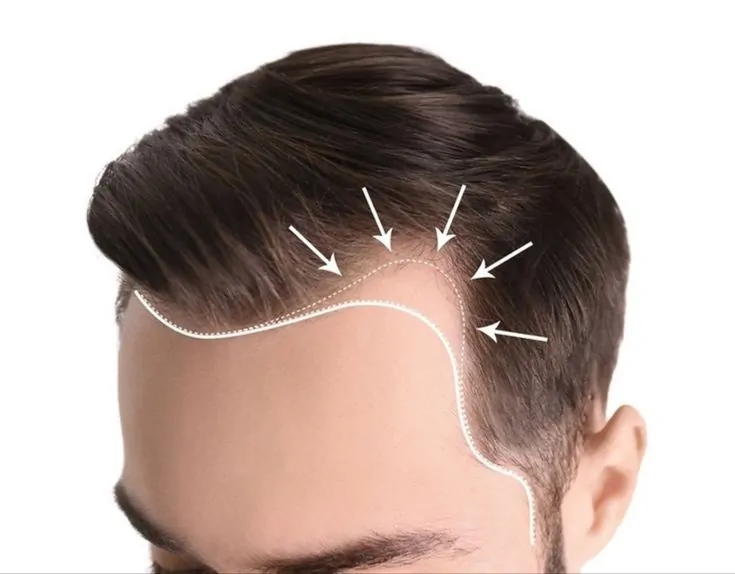The hairline is one of the most defining elements of facial aesthetics. A receding hairline over time can lead to significant cosmetic concerns in both men and women. Factors such as genetics, hormonal changes, and environmental influences can contribute to this condition. Thanks to modern medicine and aesthetic treatments, hairline restoration is now possible with effective and natural-looking results.
Why Does the Hairline Recede?
A receding hairline may occur due to genetic predisposition, hormonal changes (particularly the DHT hormone), aging, chronic stress, poor nutrition, or certain dermatological conditions. The most common cause in men is androgenetic alopecia, while women may experience hairline thinning due to hormonal imbalances and thyroid disorders.
Receding Hairline in Men and Treatment Options
In men, the hairline typically starts receding from the temples, creating an “M-shaped” pattern. In advanced cases, hair loss can also affect the crown (vertex). Treatment options include:
-
Pharmacological Treatments: Topical or oral medications such as Minoxidil and Finasteride.
-
Regenerative Therapies: PRP (Platelet-Rich Plasma), exosome therapy, and stem cell treatments.
-
Surgical Methods: Hair transplantation using DHI or FUE techniques.
Hairline Problems in Women and Solutions
In women, hairline recession usually presents as thinning across the forehead. It can be managed with:
-
Hormonal regulation and endocrinological evaluation
-
Local treatments such as mesotherapy and PRP
-
Surgical interventions such as hairline lowering surgery or hair transplant
How is the Hairline Corrected?
Hairline correction is tailored to the individual’s anatomy. Factors such as forehead height, face shape, and age are taken into consideration. With DHI (Direct Hair Implantation), natural density, correct angle, and direction can be achieved, ensuring an aesthetic and harmonious look.
What is the Ideal Hairline?
From an aesthetic perspective, the ideal hairline:
-
Is located approximately 6.5–7.5 cm above the forehead
-
Appears slightly curved in the midline
-
Matches the proportions of the face, age, and gender
Hairline Design: Achieving a Natural Look
A natural hairline begins with the placement of fine, single hair follicles in the frontal zone. Slight zigzag patterns and asymmetry prevent an artificial appearance. The DHI technique allows precise implantation, ensuring millimetric accuracy.
Determining the Frontal Hairline
When planning the frontal hairline, the following anatomical references are considered:
-
Distance between the glabella (center of the forehead) and the hairline
-
Angle of the lateral temporal line
-
Vertical and horizontal proportions of the face

Temporal Hairline and Its Aesthetic Role
The temporal hairline frames the face and plays a critical role in youthful appearance. Particularly in open hairstyles, symmetry and fullness in this area create a healthy, rejuvenated look. The DHI method is frequently chosen to restore the temporal hairline naturally.
Signs and Prevention of Hairline Recession
Clinical Symptoms:
-
Thinning in the forehead area
-
Recession at the temples
-
Widening of the hair part line
Preventive Measures:
-
Nutritional supplements (biotin, zinc, iron)
-
Avoiding damaging hair practices
-
Regular dermatological monitoring and early intervention
Methods for Hairline Restoration
-
DHI Hair Transplant: Direct implantation with implanter pen, ensuring precise angle and density.
-
FUE Hair Transplant: Extraction with micromotor and implantation after channel opening.
-
Supportive Treatments: PRP, exosome therapy, mesotherapy.
Natural Home Remedies for Supporting the Hairline
-
Scalp massage with natural oils (rosemary, peppermint, argan oil)
-
Topical onion juice application
-
Stress management and healthy sleep hygiene
-
B vitamins and antioxidant support
⚠️ These remedies may support scalp health but cannot replace medical treatments in advanced cases.
Temple Hairline Recession
Temple hairline recession is often associated with aging but can be accelerated by genetics. Using the DHI technique, the temple region can be restored for a balanced and aesthetic facial frame.
Forehead Hairline and Hairline Lowering Surgery
A high forehead, particularly in women, may cause cosmetic concerns. Hairline lowering surgery or hair transplantation in Turkey can effectively reduce forehead size, achieving a more proportional and balanced facial appearance.
Hairline Shaping with DHI Technique
The DHI method is one of the most advanced techniques for shaping the hairline. It allows precise control of angle and direction, ensuring natural and permanent results, with a faster and more comfortable healing process compared to other methods.
Can the Hairline Be Reconstructed with Hair Transplantation?
Yes. Modern methods such as DHI and FUE allow reconstruction of the hairline in accordance with anatomical and aesthetic norms. With personalized planning, results are both natural and long-lasting.
Hairline Transplant Cost in Turkey
The cost of hairline transplant varies depending on the method used, the number of grafts, the surgeon’s experience, the clinic’s location, and additional services provided.
| Method | Best For | Advantages | Recovery | Pricing Model* |
|---|---|---|---|---|
| DHI Hair Transplant | Frontal hairline & temples | Precise angles, natural density | Quick social return (~1 week) | Package-based |
| FUE Hair Transplant | General hair loss areas | Wide coverage, proven technique | Moderate (~7–10 days crusting) | Graft-dependent |
| PRP Therapy | Weakened hairline | Strengthens follicles | Minimal, same day | Session-based |
| Mesotherapy | Early thinning | Scalp nutrition | Minimal | Session-based |
| Hairline Lowering Surgery | High forehead | Immediate reposition | Surgical recovery | Surgical fee |
* Pricing data varies by case, graft need, surgeon, and clinic services.
Frequently Asked Questions (FAQ)
1. Is hairline recession permanent?
If caused by genetic or hormonal factors, it is usually progressive and permanent. However, medical and surgical treatments can slow or stop progression.
2. How many grafts are needed for a hairline transplant?
Typically, 500–1,200 grafts are sufficient for the frontal hairline. Additional grafts may be required if temples are included.
3. Is hairline transplant painful?
The procedure is performed under local anesthesia, so patients do not feel pain. Mild sensitivity may occur after the operation.
4. Can a natural-looking hairline be achieved?
Yes. With the correct technique and an experienced surgeon, the hairline design can look completely natural.
5. Do home remedies restore the hairline?
While oils and massages may improve scalp health, they cannot regrow lost hair. Medical treatments are necessary for effective results.

